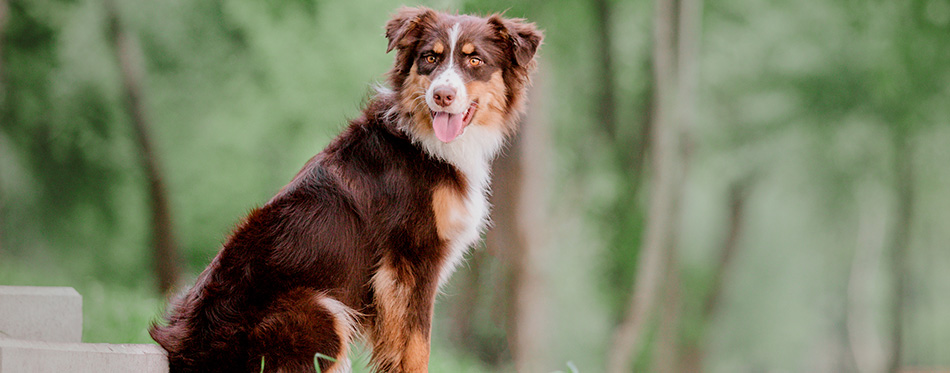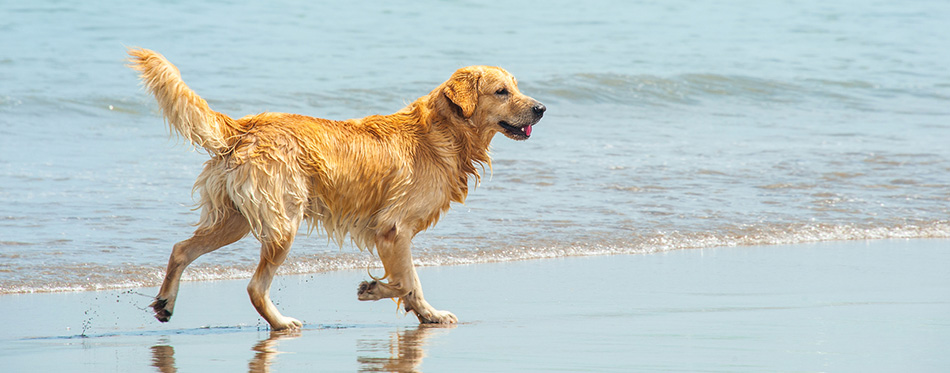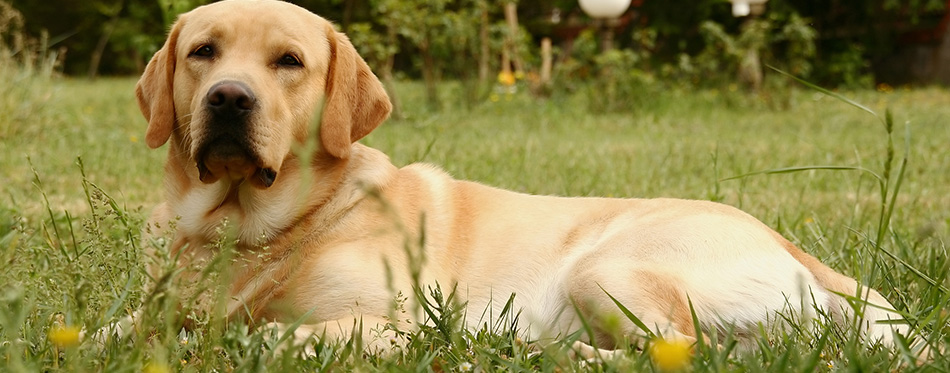Dogs will always be pure bundles of joy regardless of whether they’re purebred or mixed breed. Take for instance the Aussiedor, an interesting mix of Australian shepherd and Labrador retriever. The Aussiedor is best known for its mellow character, although it can still be as playful as any other hound. It’s smart, strong, and majestic and will stop at nothing to form and strengthen that special bond it yearns from its human family. Perfectly suited for families with kids, the Aussiedor is a medium-sized crossbreed that thrives in the warmth of its family’s love and affection. It could very well be the companion of a lifetime for members of the local lonely hearts’ club. Whatever role you give the Aussiedor, you can always bet that its intelligence and gentle nature will always come out on top. But, is it right for you? To find out, you’ve got to keep on reading.
History of the Aussiedor
Dog designers have always been looking for the best possible combination of purebred dogs to come up with a new breed that carries all the fine qualities that they are looking for in their ‘ideal’ dog. This has always been the case ever since man began domesticating dogs of the wild. The same is true with the Aussiedor, sometimes called the Australian Sheprador.
We can only surmise that whoever created the Aussiedor wanted to combine the unique qualities of both the Australian Shepherd and the Labrador Retriever. Both dogs are known for their trainability, loyalty, and above all, intelligence. What you are actually getting is the remarkable herding instincts of the Aussie coupled with the hunting prowess of the Lab. Combining the two should definitely result in a winning formula that is perfect for sporting, hunting, and herding activities.
So, where did the Aussiedor originate? Your guess is as good as ours, although anecdotes seem to suggest that it was designed in the US some time in the last quarter of the 20th century.

How are the Parents?
Crossbreeding an Australian shepherd with a Labrador retriever seems like the perfect combination of two of the world’s smartest and well-mannered dogs. To get you up to speed on whether the Aussiedor deserves such accolade, let’s take a look at its parents first.
Australian Shepherd
You’d be forgiven for thinking that the Australian Shepherd is a dog from Down Under, sharing the same landscape as the kangaroos, koalas, and wallabies. On the contrary, this medium-sized breed that can grow up to 23 inches and weigh up to 50 pounds is proudly American-made.
To be more specific, this herding dog was developed in the American West especially in the Rocky Mountains where it serves as the tireless sheep herder of ranchers in Boulder, Colorado in the 19th century. News of the dog’s remarkable sheep-herding abilities spread as far as California. Not long after, the Aussie steadily rose to fame as its legendary herding skills are rarely matched by other breeds.
The Aussie traces its roots to the Basque region of Spain where it was also used by Spanish sheep herders as the lieutenant in the field, drilling the livestock to behave. It is believed that some of these Basque shepherds brought their dogs with them when they migrated to the US West Coast, passing through Australia.
The Australian Shepherd, number 17 on AKC’s list, is well-regarded for its intelligence, flexibility, speed, athleticism, endurance, energy, and independence. On the field, it is the marshal supervising the flock and protecting them from any predator that may want to snatch one or some of its ward. In contests, it is a performer and a very likable champion at that. With its family, it loves to play Frisbee and flyball, although it can actually play every conceivable type of dog sports. It’s small, yes, but it also has very powerful legs that can propel it to gazelle-like speeds. Its hind legs are like that of a bullfrog, allowing the Aussie to jump as high as 4 feet.
Given that the Aussie is such a very active dog and that it thrives on the attention and recognition that it gets, this dog is never for couch potatoes or lazy heads (sorry for the term). It’s the kind of dog that will stop at nothing just so it can get that physical activity and mental stimulation it requires. Otherwise, it will only end up a sad, bored, and unhealthy pooch.
Labrador Retriever
Like all gun dogs of the retriever type, the Lab is best known for its swimming abilities. It shuttles messages across boats anchored on the bay while also helping fishermen pull out their fish-laden nets from the water. It’s a characteristic that has endured through the centuries and one that is highly valued to this very day.
Number 1 in the hearts of American, Canadian, and British dog-lovers, the Lab is a service dog with untarnished reputation when it comes to aiding people with disabilities. They are the perfect companion for those in sorrow and grief and individuals who think that they are all alone in this universe. One look at the Lab’s soulful and meaningful eyes is often enough to stir one’s soul. And if you’re a cry-baby, you’d definitely need more than a box of Kleenex to dry up your tears.
The Lab is an adorable breed. It is used as a therapy dog and cancer patients who have spent their twilight years in the company of a Lab have attested to the unconditional and uncompromising attitude of the breed. It thrives on human compassion. The mere touch of its paws is enough to bring comfort to the ill in the same way as the loving embrace of a pet owner on its muscular body is more than enough acknowledgement of the dog’s gentle and endearing nature.
Kind, outgoing, and very pleasant, the Lab can grow up to 24 inches and weigh about 80 pounds max. It’s a sporting dog that dislikes idle days. It’s a very sociable hound that cries or begs for attention. Leave not a Lab for so long, lest it goes into separation anxiety and severe depression. It’s a working dog and while it is smart, it will still need training and supervision especially as a pup. If you cannot adhere to these very simple terms, you’ll find that a miserable Lab will never be a bundle of joy in your home.
If you are looking for more options, check out our guide on the Best Dog Food for Labs.
Quick Facts
Knowing that the Aussiedor comes from equally smart and gentle-natured parents is quite comforting. However, because its parents are also very active working dogs in their respective classes, the Aussiedor may not actually be suitable for couch potatoes; unless you don’t mind having a dog that has serious behavioral issues because of boredom. Here are other interesting facts you may want to know about the Aussiedor.
- The Aussiedor is not a purebred; let’s get that straight. However, it is recognized as a hybrid by the International Designer Canine Registry, the American Canine Hybrid Club, the Designer Dog Kennel Club, and the Dog Registry of America.
- A male Aussiedor can grow up to 23 inches and weigh about 35 to 80 pounds. The female Australian shepherd Labrador Mix is usually shorter by a few inches and lighter by a few pounds.
- The coat can take on a chocolate or light brown color, although black and a combination of colors are quite common.
- As for the markings on its coat, you can expect it to be spotted, speckled, brindled, or in classic Australian merle pattern.
- The thickness of the coat varies, often depending on the more dominant parent. It can be wavy or straight, but definitely water-repellent.
- Expect the Aussiedor to have moderate shedding which can mean it’s not ideal for people who absolutely hates pet hair on their furniture, floors, or carpets.
- Aussiedors are very playful and highly active and love running, walking, and water-related adventures.
- This mix breed is affectionate and devoted, too. However, it may be prone to separation anxiety if not properly trained or socialized.

Things You Should Know
Do you think you’re the right pet parent for an Aussiedor? Before you even answer this question, try reading these very important things that you should know about the Australian shepherd Labrador Mix. This way you’ll have a fair idea of what to expect and determine whether this crossbreed fits well into your lifestyle.
Training
They are smart, but this doesn’t excuse you from the job. Train the Aussiedor as a puppy and you’d be gifted with a hound that not only follows your every command, but can also show off some of its inherent skills. Born to both entertain and please its human master, the Aussiedor has the intelligence and easy trainability of its parent breeds. Spend as much time teaching your dog a certain trick at a time. Adhere to the principles of positive reinforcement and you’ll be rewarded with a nimble dog that is as proficient in retrieving a tossed Frisbee as it is prolific in performing a variety of dog tricks. If you are looking for more options, check out our guide on dog frisbees.
A very important aspect of Aussiedor training is taming its herding instincts, especially in the presence of young kids. Train it well and you’ll have a four-legged guardian and protector of your children.
Feeding
If there’s one thing that best describes a Lab, that would be its voracious appetite. Leave a bowl of dog food and it will be gone in a flash. We’ve seen home-made videos of Labs purposely opening ref doors and going on a binge. Be careful as the Lab in your Aussiedor can easily manifest itself. If not, you’ll end up with the doggie version of Garfield in your midst. Now all you need is Odie to complete the duo.
The Aussiedor is quite muscular and a highly active dog. Expect to give it calorie-dense dog food, but preferably one that has more animal proteins than carbs. Proteins are needed for muscle development and it is the Aussiedor’s muscles that will help it accomplish many of its tasks. Vegetables and fruits should always be considered as these are rich in antioxidants necessary for a healthier immune system, not to mention better skin and coat.
Check out our guides on the Best Organic Dog Foods and Best Grain Free Dog Foods for more info.
Exercise
A full grown Aussiedor requires at least an hour of heavy physical exercise every single day. It is for this reason that they are best reserved for highly active individuals who don’t mind hitting the track after office hours just so their pets can also have the exercise they need. And if in case you’re not really into outdoor exercises but more of a gym fanatic, then that should work, too. Get your Aussiedor on the treadmill and join it as you push yourself on the wheels.
Even if you don’t exercise, engaging an Aussiedor in highly vigorous play activities can do a lot of wonders for your crossbreed. Got access to a lake or pond? Try throwing buoyant balls into the water and watch your dog jump right in. Frisbees and flyballs are a favorite. You can even play with laser pointers right inside your home. The trick is to get its joints moving and the muscles contracting. But be always ready with their water and plenty of rest afterwards. Find out more about dog treadmills here.
Socialization
Aussiedors easily make friends with other pets. That is if you’re able to train them early on. Some dogs are quite aloof and very rigid for the simple fact that their pet parents never bothered to socialize them when they were still puppies. So make sure you create opportunities where your young Aussiedor is able to meet and interact with other pets.
The same is true with other people. This crossbreed is people-friendly only if you trained it to be as friendly to other people as it is to the members of your family. It shouldn’t be difficult especially since both the Labrador and the Australian shepherd are well-known for their amiable nature. It should be a cinch to learn how to make friends for the Aussiedor.
Grooming
The Aussiedor will often have a double coat. If it gets it from its Labrador parent, expect the coat to be short. If from its Aussie parent, it will be medium-length. If this is the case, you’d have to be ready with your grooming chores. Daily brushing is ideal, although twice or thrice a week should be sufficient. Tooth-brushing, nail-clipping, ear-cleaning, and general grooming should also be scheduled on a regular basis as this can help secure better health for your hound.
One note, however, is that Aussiedors are moderate shedders. As such, if you absolutely hate having to pick up loose pet hair from your carpet and furniture, then you might want to think twice about getting such a dog. Alternatively, you can try a dog deshedding brush tool which should help get rid of loose hair from your pet’s coat. Head over to our reviews of dog ear cleaners and dog shedding brushes for more choices.
Health
Physically active and rambunctious as Aussiedors are, they aren’t exactly immune to health problems. Chief of these is hip dysplasia so you might want to invest in a really good canine food that comes with excellent sources of glucosamine and chondroitin, although supplementation should do just fine.
Aussiedors are also prone to cataract formation, progressive retinal atrophy, and even autoimmune thyroiditis. Of course, joint disorders will always be there, not necessarily because of a genetic predisposition to the disorder but more so because of its active lifestyle that can expose it to activity-related injuries.
For fairly obvious reasons, the Australian shepherd Lab Mix is ideal for the following pet parents:
- They can commit to training and socializing their Aussiedor as early as possible.
- They don’t have any issues brushing the Aussiedor’s coat every day or at least every other day, brush its teeth, clean its ears, trim its nails, and provide regular grooming.
- They can devote at least an hour of outdoor playtime activities as well as exercises.
- They have kids that they can teach how to properly handle and care for an Aussiedor.
- They can provide high-quality animal protein-based dog food for their Aussiedor.
- Families who don’t like barkers.
- Pet parents who may have other pets in the household.
The Aussiedor is definitely not for you if you are any of the following:
- A couch potato or one who don’t like exercise or playing outdoors.
- A person who dislikes having furniture, carpets, floors, and other surfaces filled with hair.
- Someone who doesn’t want to hug, embrace or even pet his or her dog.
- An individual who clearly doesn’t have any idea of the basics of training and socializing puppies.
- A person who leaves the dog alone in the house for more than 8 hours.

Temperament
Aussiedors have taken the gentle nature, loyalty, kindness, and friendliness of their respective mommies and daddies. Forever affectionate, an Aussiedor thrives in the warmth of human companionship where it is able to forge and strengthen ties with its human family. Be careful, though, as the Aussiedor can be quite clingy especially to a certain member of the family. That being said, an Aussiedor can also have separation anxiety which should be addressed as early as possible.
The Aussiedor is a lively hound that loves to ‘work’. It loves the attention and affection it gets from its family. You’ll be proud to have it in your home if you can meet its fundamental needs.
Source:
- Australian Shepherd Lab Mix – Top Facts About The Aussiedor – Animal Corner

